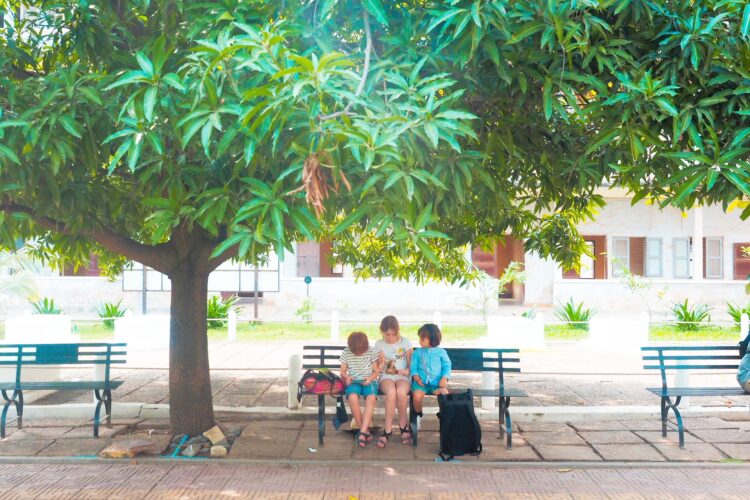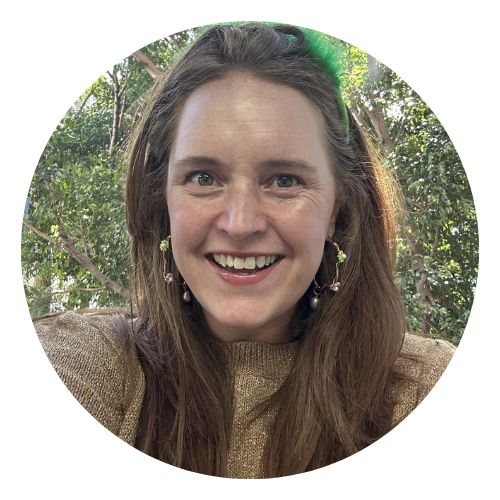Can you take children to The Killing Fields and S-21 prison? This was our question here in Phnom Pehn. We both really wanted to go, but knowing what we do the Khmer Rouge and Pol Pot Regimes we knew that these would be harrowing places for adults, let alone children. Getting this wrong for our children could well be the stuff nightmares were made of.
S-21, The Tuol Seng Genocide Museum, was once a school. Standing amidst in the lush grounds, with the breeze cutting through the dense heat it’s easy to see why it would be a perfect spot for children to play and learn. When the Khmer Rouge took Phnom Pehn on April 17, 1975 they sent everyone out of the city. The pretence was that the city wasn’t safe due to the Vietnam War and American bombs. However once they had left, no one was allowed to return – they were to work in the country, part of Pol Pot’s distorted vision to turn the country into a big farm.
When this happened, the city was run by the Angkar (the organisaion) and the school was turned into a prison. Cambodians accused of illegal activities were taken here, most were never told why there were arrested or what they were charged with. S-21 became a place of torture and death, somewhere the remaining inhabitants of the area called “The place where people go in and never come out”. It is believed that over 14,000 Cambodians were brought here, tortured into making false confessions and then executed. Standing in the lush grounds today, the grey buildings behind the trees are a stark contrast. They now house the photographs of some of the inmates of the prison, stories from victims, torture equipment and more remnants of this part of Cambodia’s dark past.
Of course, we knew little of this before we arrived. All we knew was that having visited the War Museum in Ho Chi Minh city a few years ago (one of the most harrowing and upsetting places I’ve ever visited) we knew there was every chance one of us would end up standing outside S-21 with the children!
As it turns out, the beautiful grounds of S-21 offer some emotional relief from the prison. They are replete with shady benches for you to sit and contemplate and in our case, allow our children to sit. Having decided to take the children, we also went prepared. Both S-21 and The Killing Fields are very sombre and quiet places. So our other consideration in taking them (mainly the 4 year old!) was could they be quiet and respectful? And then, what could we do to make it easier for them? (We were are S-21 for 2 hours and as I may have already mentioned, it’s very hot here!) So we loaded up the backpack with headphones and had our ‘devices’ ready in case it was too much for the children.
As we’ve travelled through the country so far we have been sharing bits about Cambodia’s past with kids. In Siem Reap we visited the Landmine Museum where our 8 year old did the audio tour with us and our 6 year old and I talked about the history. The children witnessed quite a few landmine victims as we explored the temples so there was a natural opportunity to talk with them about it.
When we got to S-21 both our 8 and 6 year olds wanted to do the audio tour with us again. We took some advice from a fellow traveller decided to manage this by pressing play on the audio a minute or so before them so that we could decide if something wasn’t appropriate and which exhibits we might need to skip. Our 6 year old listened to the first few and then felt it was to sad to listen anymore. He and I had a good but simple chat about why this had all happened and then he joined his younger brother in watching the iPad (As everyone had headphones on it went pretty unnoticed that the children were on their devices and this is the only occasion we would allow them to do this). Our 8 year old listened through to the end of Building B (the first 16 of the 29 items on the audio tour before she stopped) and this suited us as Buildings C & D were the more confronting.
The prison was a profound place to visit and we really got the sense that the Cambodian people want you to visit – to see and remember their history. At the end of our visit we met Bou Meng, one of the seven survivors of S-21. We bought his book and he invited us to have a photo with him which was very moving.
We left S-21 feeling heavy-hearted. Obviously the main question our children had was WHY? Why did this happen? Why did they do this? Even this morning my daughter has asked But why would they kill children? It’s hard to answer this question because of course, there is no answer, no rational for such rampant murder. We just had to be honest with the kids about this, that it was just evil.
As we headed out to The Killing Fields (they are about 30 minutes outside of town) our 6 year old expressed a bit of concern about having to listen to more sad things. When we reassured him that he did not need to listen to anything and that he could just sit quietly, he was fine. (Hot, but fine!)
It is estimated that 1-3 million Cambodians were killed in what are now known as The Killing Fields. Mass, unmarked graves where bullets were spared and other methods of execution were used to murder men, women and children as if they were animals. As I walked around and listened to these stories I wondered, what have we learnt? Yemen, Syria – in these places, right now, people are enduring such horrors, perhaps similar horrors to those that took place in these grounds. We know about them only because of social media, because people are able to get their own stories out. Otherwise….what is different? Why have we not learnt? How can genocide still occur in the 21st century?
The Killing Fields are deeply moving and yet strangely beautiful. Situated next to rice fields the grounds are lush green and full of butterflies. It seems such an unlikely spot for the incredible atrocities that occurred here. When you remove your headphones from the audio tour, the unrestrained laughter of children from a neighbouring school greets you. Again this gives a kind of relief from the heaviness of the place.
None of our children did the audio tour here though we would have been comfortable with them listening to parts of it had they wanted too. (I found the pictures and information shared by Acts of Travelling to be really helpful in making our decision about coming here). Mark and I took turns walking around and listening to the tour and then Mark (who is so good at explaining things in an age appropriate way) walked the children around the grounds and shared bits of the history with them – this really helped them to engage but also not be overwhelmed. As a family we all went into the Stupa, filled with bones that have been excavated from the area – this was something even our 4 year old could appreciate.
We finished our day with a Sunset Cruise on the Tonle Sap, it was quite a contrast from our day and a good opportunity to reflect quietly on what we had seen and experienced.
In taking our children with us we wanted to share some of the history with them, but not overwhelm them. There were certainly many children at both places, most of the children who were older than our daughter (she is 8) were doing the audio tours with their parents. I am glad we took them, certainly glad that we went. I hope that what they saw and experienced today will be part of their understanding of what the world needs and that their innocent questions will remind us, the grown ups, of what is required of us. To act justly and to love mercy and to walk humbly with your God. Micah 6:8







Beautiful story! Reading this brings me back to those moments when we visited these places. And you are so right, why don’t we learn from the past? I can so imagine that right now, with again the evil things that are happening in the world, this visit will impact you even more. I am so glad you decided to visit with your kids. Here’s to travel being an essential piece of education for our kids.
I think you and Mark made a thoughtful and very wise decision to take the children to these places. I’m not one for shielding children from history. In my case, I know that’s very strongly driven by my memories of my father – a refugee. Of course, filtering by age and emotional development is important, but so is access to such knowledge. This the world our children inhabit. Now the news has images from Yemen and Syria. It’s our duty as parents to gently prepare our children for the world they are entering. And I’m so terribly sad to say, that as a historian, I fear darker days are ahead.
And the verse from Micah is perfect.
Thanks Anna, those are very kind words. It definitely was a thought-out decision and I really agree with you that we need to give our kids access to this information, in an age appropriate way. I met a number of people, adults, who weren’t going to either place because they felt they would find it too sad and upsetting. I don’t know that we have the right, as adults, to shy away from these hard truths – the world needs us to face up to them and to do something about it so that future generations and nations don’t suffer the same fate.
[…] the sombre war museums in Phnom Penh and learnt more about the country under Pol […]
[…] pondering whether or not we would take the children to the Killing Fields and S21 (Tuol Sleng) we decide to […]